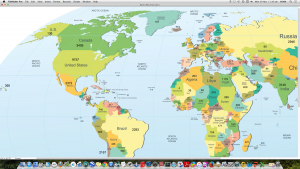The U.S. is badly invaded by non-native plants. In the database he maintains,
Rod Randall of Western Australia reports that more than 9,700 non-native plant species are naturalized in the U.S. In this compendium, Randall defines “naturalized” species as those having self-sustaining and spreading populations with no human assistance. Not all of these species impact upon the environment.
As noted, not all 9,700 species are “invasive”. It is likely that a significant proportion of the invaders are “weak” invaders which coexist with the native plants and make up minor components of the plant community. Others are “strong” invaders that can rapidly attain community dominance and dramatically impact native species and ecological processes (Ortega and Pearson 2005).
But the evidence is that the situation will grow worse. A study of a small proportion of the naturalized plants (1201 alien species; 755 invasive; Bradley, Early & Sorte 2015) found that
– Invasive and alien plants are more widely distributed than natives across the continental United States
– The average invasive plant now inhabits only ~ 50% of its expected range
– Biological factors are less important than human actions in facilitating spread
According to Dr. George Beck of Colorado State University, by 2015, the acreage of land managed by the BLM that is invaded by non-native plants exceeds 77 million acres – more than twice the areas reported in 2009 (35 million acres) (see Dr. Beck’s testimony here). I noted in my blog about threats to U.S. National parks that are World Heritage sites (October 21, 2015), National parks from Hawai`i to Florida have been badly damaged by invasive plants.
Another source reports that more than 500 plant species invasive in some region are being sold on-line globally (Humair et al. 2015).
USDA APHIS has adopted a pre-import risk-screening system. Based on these analyses, utilizing the NAPPRA process, in April 2013 APHIS determined that 41 plant species may not be imported until a risk assessment has been conducted because of the risk they pose of being invasive. APHIS proposed a second group of species, containing 22 species, in May 2013. However, this list has not been finalized two and a half years later – despite meeting with conservation organizations/stakeholders in April 2015 at which we discussed ways to speed up the approval process. (We were told that the delay is caused by controversy over taxa proposed for NAPPRA-listing because their link to plant pests; that there is no controversy over the taxa to be restricted as potentially invasive plants.)
Clearly the threat from invasive plants is great and growing. The U.S. Department of Agriculture needs to adopt procedures that enable APHIS to act more quickly to curtail introduction and human-assisted spread of invasive plants. APHIS and federal land-managing agencies need adequate resources to develop and apply effective and environmentally sound control measures.
Sources
Bradley, B.A., R. Early & C. J. B. Sorte. 2015. Space to invade? Comparative range infilling and potential range of invasive and native plants. Global Ecology and Biogeography
Humair, F., Humair, L., Kuhn, F. and Kueffer, C. (2015), E-commerce trade in invasive plants. Conservation Biology, 29: 1658–1665. doi: 10.1111/cobi.12579
Ortega, Y. K. and D. E. Pearson. 2005. Strong versus weak invaders of natural plant communities: assessing invasibility and impact. Ecol. Appl. 15:651–661
posted by Faith Campbell

